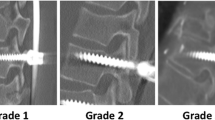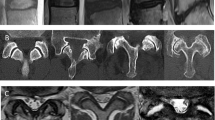Abstract
Purpose
To explore the characteristics of spontaneous facet joint fusion (SFJF) in patients after oblique lateral lumbar interbody fusion combined with lateral single screw-rod fixation (OLIF-LSRF).
Methods
We randomly selected 300 patients from 723 patients treated with OLIF-LSRF into a cross-sectional study based on the pilot study results. A novel fusion classification system was designed to evaluate the fusion status of the facet joints at three time points. Ultimately, the prevalence, characteristics, and significance of SFJF were analyzed.
Results
A total of 265 (333 levels) qualified cases were included in our study. The novel classification for SFJF has excellent reliability (kappa > 0.75). The rate of SFJF was 15.20% (45/296 levels) at 3 months postoperatively, 31.34% (89/284 levels) at 6 months postoperatively, and 33.63% (112/333 levels) at the last follow-up. The circumferential fusion rate was 31.53% (105/333 levels) at the last follow-up. The location of SFJF was mostly on the right facet joint (P < 0.001), and the rate of SFJF increased significantly from 3 to 6 months after the operation (P < 0.001). The average age of patients with SFJF was older than that of patients without SFJF (P < 0.001). There was no significant difference in Visual Analog Scale or Oswestry Disability Index scores between patients with and without SFJF.
Conclusion
In the OLIF-LSRF procedure, SFJF occurs mostly at 3–6 months postoperatively, especially in elderly patients and at the right facet joint. OLIF-LSRF has the potential for circumferential fusion.






Similar content being viewed by others
References
Proietti L, Perna A, Ricciardi L et al (2021) Radiological evaluation of fusion patterns after lateral lumbar interbody fusion: institutional case series. Radiol Med (Torino) 126:250–257
Izeki M, Fujio K, Ota S et al (2021) Radiological follow-up of the degenerated facet joints after lateral lumbar interbody fusion with percutaneous pedicle screw fixation: Focus on spontaneous facet joint fusion. J Orthop Sci S0949–2658(21):00215–00223
Shimizu T, Fujibayashi S, Otsuki B et al (2021) Indirect decompression via oblique lateral interbody fusion for severe degenerative lumbar spinal stenosis: a comparative study with direct decompression transforaminal/posterior lumbar interbody fusion. Spine J 21:963–971
Wang K, Zhang C, Cheng C et al (2019) Radiographic and clinical outcomes following combined oblique lumbar interbody fusion and lateral instrumentation for the treatment of degenerative spine deformity: a preliminary retrospective study. Biomed Res Int 2019:5672162
Bereczki F, Turbucz M, Kiss R et al (2021) Stability evaluation of different oblique lumbar interbody fusion constructs in normal and osteoporotic condition—a finite element based study. Front Bioeng Biotechnol 9:749914
Wang X, Ji X (2020) Sample size estimation in clinical research: from randomized controlled trials to observational studies. Chest 158:S12–S20
Meleis A, Larkin MB, Bastos DCA et al (2021) Single-center outcomes for percutaneous pedicle screw fixation in metastatic spinal lesions: can spontaneous facet fusion occur? Neurosurg Focus 50:E9
Kim KW, Ha KY, Moon MS et al. (1999) Fate of the facet joints after instrumented intertransverse process fusion. Clin Orthop Relat Res, pp 110–119
Tromme A, Charles YP, Schuller S et al (2019) Osteoarthritis and spontaneous fusion of facet joints after percutaneous instrumentation in thoracolumbar fractures. Eur Spine J 28:1121–1129
Siepe CJ, Stosch-Wiechert K, Heider F et al (2015) Anterior stand-alone fusion revisited: a prospective clinical, X-ray and CT investigation. Eur Spine J 24:838–851
Fleming TR (2011) Addressing missing data in clinical trials. Ann Intern Med 154:113–117
Bland JM, Altman DG (1986) Statistical methods for assessing agreement between two methods of clinical measurement. Lancet 1:307–310
Gazzeri R, Panagiotopoulos K, Princiotto S et al (2018) Spontaneous spinal arthrodesis in stand-alone percutaneous pedicle screw fixation without in situ fusion in patients with lumbar segmental instability: long-term clinical, radiologic, and functional outcomes. World Neurosurg 110:e1040–e1048
Satake K, Kanemura T, Nakashima H et al (2018) Nonunion of transpsoas lateral lumbar interbody fusion using an allograft: clinical assessment and risk factors. Spine Surg Relat Res 2:270–277
Charles YP, Walter A, Schuller S, Steib JP (2017) Temporary percutaneous instrumentation and selective anterior fusion for thoracolumbar fractures. Spine (Phila Pa 1976) 42(9):E523-e531.
Yson SC, Sembrano JN, Sanders P C et al. (2013) Comparison of cranial facet joint violation rates between open and percutaneous pedicle screw placement using intraoperative 3-D CT (O-arm) computer navigation. Spine (Phila Pa 1976) 38:E251-E258
Oh H-S, Seo H-Y (2021) The Relationship between Adjacent Segment Pathology and Facet Joint Violation by Pedicle Screw after Posterior Lumbar Instrumentation Surgery. J Clin Med, 10
Wazen RM, Currey JA, Guo H et al (2013) Micromotion-induced strain fields influence early stages of repair at bone-implant interfaces. Acta Biomater 9:6663–6674
Guo H-Z, Tang Y-C, Guo D-Q et al (2020) Stability Evaluation of oblique lumbar interbody fusion constructs with various fixation options: a finite element analysis based on three-dimensional scanning models. World Neurosurg 138:e530–e538
Cheng C, Wang K, Zhang C et al (2021) Clinical results and complications associated with oblique lumbar interbody fusion technique. Ann Transl Med 9:16
Gellhorn AC, Katz JN, Suri P (2013) Osteoarthritis of the spine: the facet joints. Nat Rev Rheumatol 9:216–224
Kettler A, Wilke HJ (2006) Review of existing grading systems for cervical or lumbar disc and facet joint degeneration. Eur Spine J 15:705–718
Acknowledgements
We would like to thank AJE (www.aje.com) for English language editing and all the patients for their data in this study. And we are grateful to the staff of our department.
Author information
Authors and Affiliations
Contributions
XP: Conceptualization, Data curation, Formal analysis, Funding acquisition, Investigation, Methodology, Project administration, Resources, Software, Supervision, Validation, Visualization, Writing—original draft, Writing—review and editing. XW: Data curation, Formal analysis, Investigation, Project administration, Visualization, Writing—review and editing. HN: Data curation, Formal analysis, Investigation, Writing—review and editing. TX: Data curation, Formal analysis, Investigation, Software. ZY: Data curation, Investigation, Methodology, Software. Writing—review and editing. LZ: Data curation, Formal analysis, Software, Writing—review and editing. RL: Data curation, Investigation, Software. JZ: Conceptualization, Data curation, Formal analysis, Funding acquisition, Investigation, Methodology, Project administration, Resources, Software, Supervision, Validation, Visualization, Writing—original draft, Writing—review and editing.
Corresponding author
Ethics declarations
Conflict of interest
All authors state that we have no conflicts of interest.
Ethical approval
Ethical approval was obtained from the Ethics Committee on Biomedical Research West China Hospital of Sichuan University (approval number: 2020–554).
Additional information
Publisher's Note
Springer Nature remains neutral with regard to jurisdictional claims in published maps and institutional affiliations.
Supplementary Information
Below is the link to the electronic supplementary material.
Rights and permissions
Springer Nature or its licensor (e.g. a society or other partner) holds exclusive rights to this article under a publishing agreement with the author(s) or other rightsholder(s); author self-archiving of the accepted manuscript version of this article is solely governed by the terms of such publishing agreement and applicable law.
About this article
Cite this article
Pu, X., Wang, X., Nie, H. et al. Spontaneous facet joint fusion in patients following oblique lateral lumbar interbody fusion combined with lateral single screw-rod fixation: prevalence, characteristics and significance. Eur Spine J 31, 3580–3589 (2022). https://doi.org/10.1007/s00586-022-07424-3
Received:
Revised:
Accepted:
Published:
Issue Date:
DOI: https://doi.org/10.1007/s00586-022-07424-3




